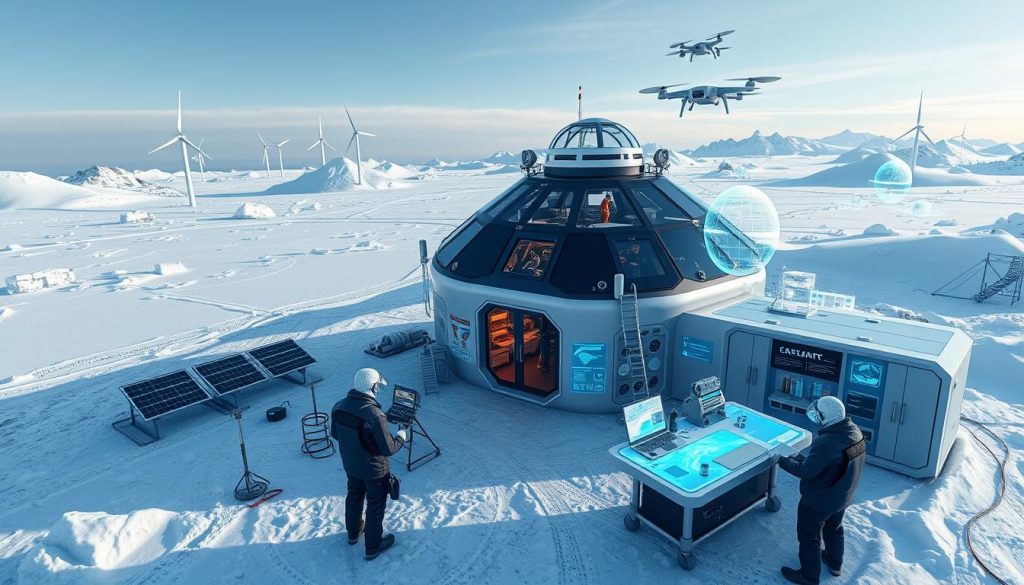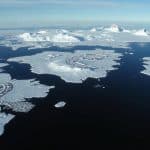Antarctica is one of Earth’s most challenging places. Yet, it’s full of opportunities for scientists and entrepreneurs. This article explores unique business concepts for researchers in this harsh setting. We’ll look at the blend of scientific pursuit and business innovation. Our focus lies on business ideas that overcome logistical challenges, use new tech, and follow eco-friendly methods. By creating new business models in Antarctic research, scientists can make discoveries that help both science and society.
Understanding the Unique Challenges of Antarctic Research
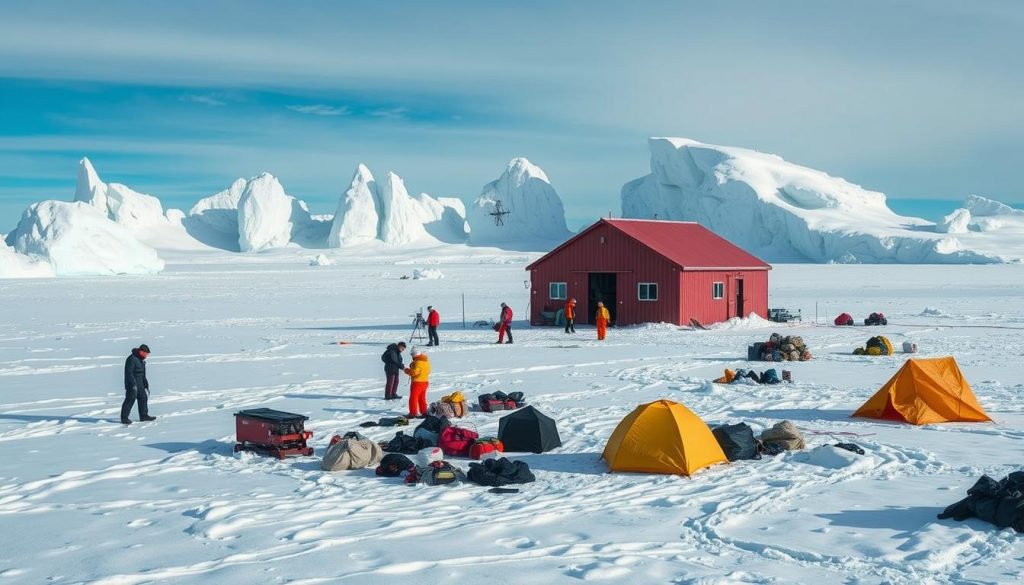
Antarctic research is full of extraordinary challenges for scientists. They face a very harsh environment. Sub-zero temperatures and strong winds create big obstacles.
Getting supplies and equipment to remote areas is a big challenge. Scientists have a short time each summer to bring in what they need. Without good facilities, research can be really tough.
- Being cut off from the world can make researchers feel isolated, affecting how the team works and feels.
- Staying for a long time can be mentally hard, showing how important support is for their mental health.
- There’s also limited access to advanced technology, making research even harder in these far-off places.
People who’ve done research in Antarctica say being resilient and adaptable is key. Knowing what to expect and being well-prepared are vital for success.
Emerging Technologies for Polar Exploration

As we venture further into polar regions, the need for new technologies grows. Tools like advanced sensor tech and satellite imaging are at the forefront. They help us understand the harsh conditions of the ice-covered areas better.
These technologies offer precise data collection. For example, satellites reveal changes in ice and weather. Sensors keep an eye on the environment constantly. These advancements are key where old methods can’t keep up.
Simulation software is also vital. It lets scientists create and test different scenarios. This helps with planning and improves expedition outcomes.
Data from places like the Scott Polar Research Institute shows how vital these technologies are. They help overcome Antarctica’s challenges, making research more effective. This leads to a deeper understanding of polar regions.
Business Ideas in Antarctica for Scientists
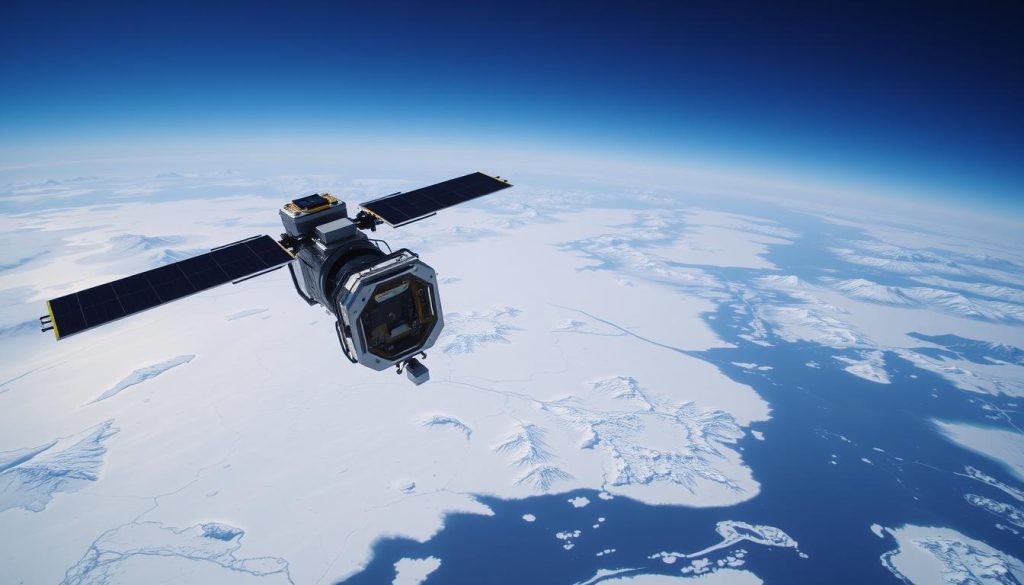
Antarctica’s unique environment offers great opportunities for scientist entrepreneurs. Setting up research camps helps support expeditions and improves scientific research efficiency. Such camps provide key services tailored to different scientific projects, making them crucial for researchers.
Research Camps and Facilitation Services
Research camps are vital for scientists doing important studies in Antarctica. These camps help with planning, managing resources, and fostering teamwork. They offer:
- Logistical support for equipment transport and setup
- Accommodation and catering for research teams
- Training on local environmental conditions and safety protocols
As the demand for remote area accommodation grows, investing in well-equipped camps can be profitable. It also supports essential scientific research.
Remote Sensing and Data Collection Solutions
Remote sensing technology has changed how scientists collect data in difficult environments. New data collection methods improve accuracy and reduce the need for tough fieldwork. Important features include:
- Utilising drones for aerial data collection
- Implementing satellite imaging to monitor environmental changes
- Employing sensors for real-time data acquisition
These advances broaden research opportunities and offer insights into climate and geology. Offering remote sensing services can make businesses stand out in the scientific field.
Eco-Friendly Innovations for Sustainable Research
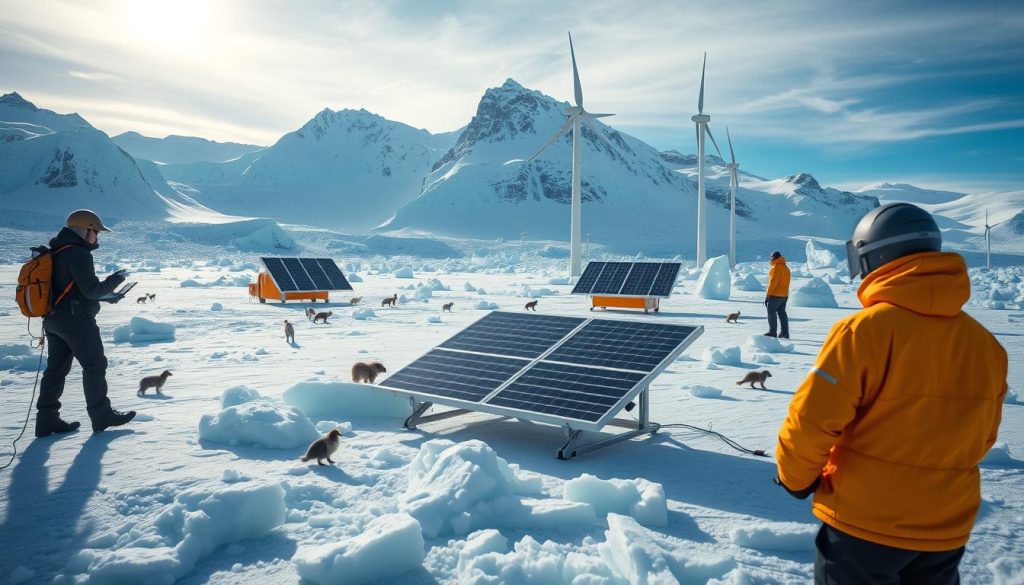
In Antarctic research, it’s vital to use sustainable practices to reduce environmental harm. Eco-friendly innovations make research more effective and sustainable. Using renewable energy sources instead of traditional ones is a major advancement.
Renewable Energy Systems
Renewable energy, like solar panels and wind turbines, is key in polar research. These systems lower fossil fuel use and support sustainability in icy places. Research facilities have seen smaller carbon footprints thanks to these innovations.
Renewable energy solutions in use are:
- Solar energy systems catch the sun’s power in summer’s long days.
- Wind turbines use Antarctica’s strong winds to create electricity.
- Hybrid systems combine solar and wind energy for year-round power.
These methods show dedication to sustainable research. They prove scientific study can be gentle on the ecosystem. With these technologies, scientists achieve valuable insights while protecting the environment.
The Role of Robotics in Antarctic Expeditions
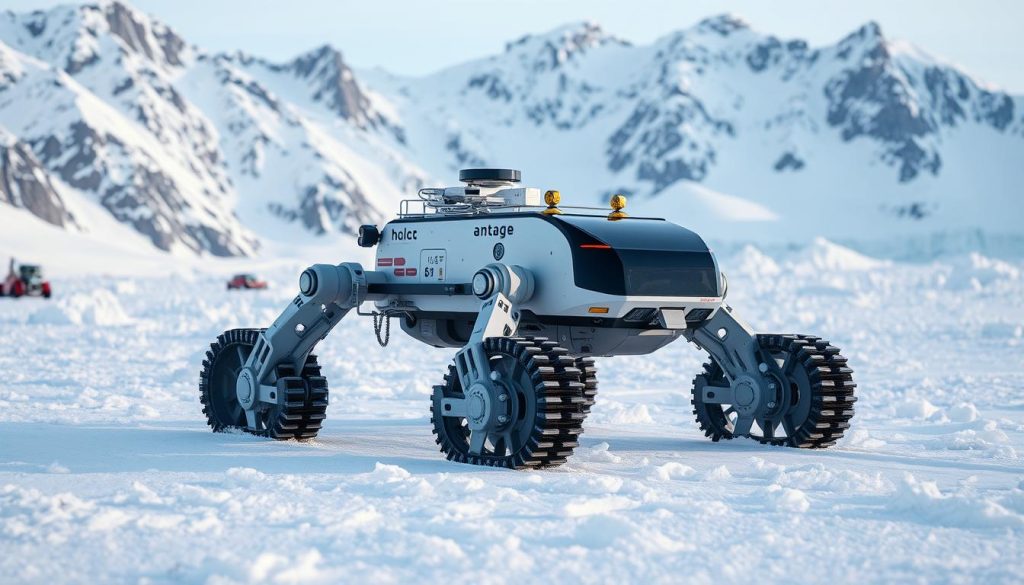
Robotics have become vital in today’s Antarctic explorations. They help researchers stay safe and gather better data in harsh conditions. Robots make tasks like surveying and monitoring the environment easier.
Automated Surveying Equipment
Automated surveying tools are key in mapping Antarctica’s tough terrain. These tools work well in cold, ensuring precise measurements. This way, researchers don’t face extreme weather and can spend more time analyzing data.
Drones for Environmental Monitoring
Drones are crucial for keeping an eye on the Antarctic environment. They conduct aerial surveys, tracking wildlife and glacier changes. This information, especially valuable for groups like the British Antarctic Survey, gives a clearer picture than traditional methods.
Collaboration with Global Research Institutions
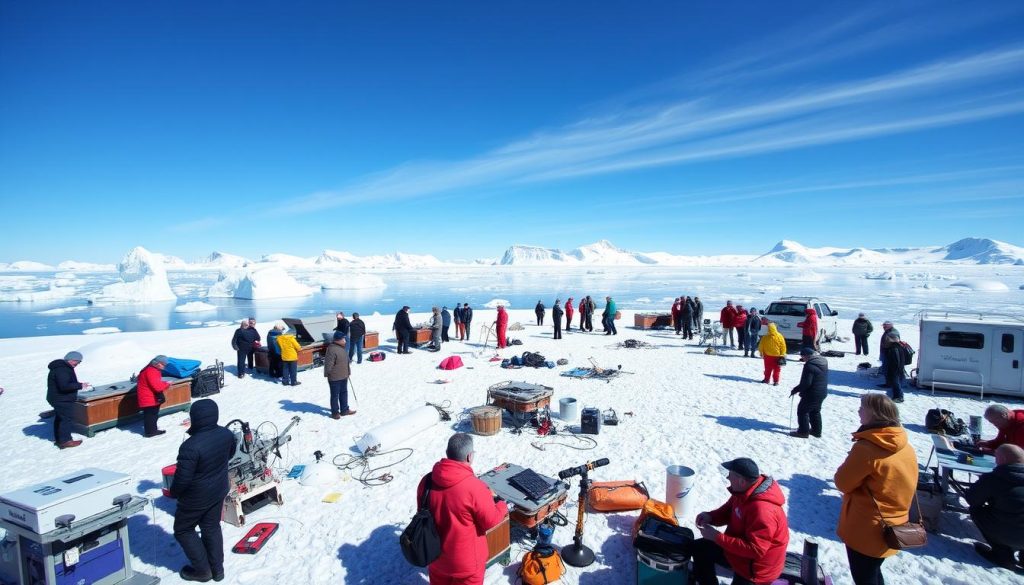
Working together in research is key for making progress in Antarctic Science. When scientists join forces with global research institutions, they tap into many resources and skills. This boosts the quality and reach of their work. These partnerships create a space where experts can share their knowledge. This helps in addressing the complex issues posed by the Antarctic region.
Teams like the International Partners in Ice Core Sciences (IPICS) show how vital collaboration is. This effort not only strengthens research but also opens up crucial funding chances. Needed for big projects. With these partnerships, scientists gain access to the latest technologies and methods. This leads to richer research findings.
Moreover, global partnerships bring varied academic views and new ways of thinking to Antarctic Science. Different expertise from around the world helps in understanding climate change better. This highlights why working together is crucial in this unique setting.
Developing Innovative Communication Solutions
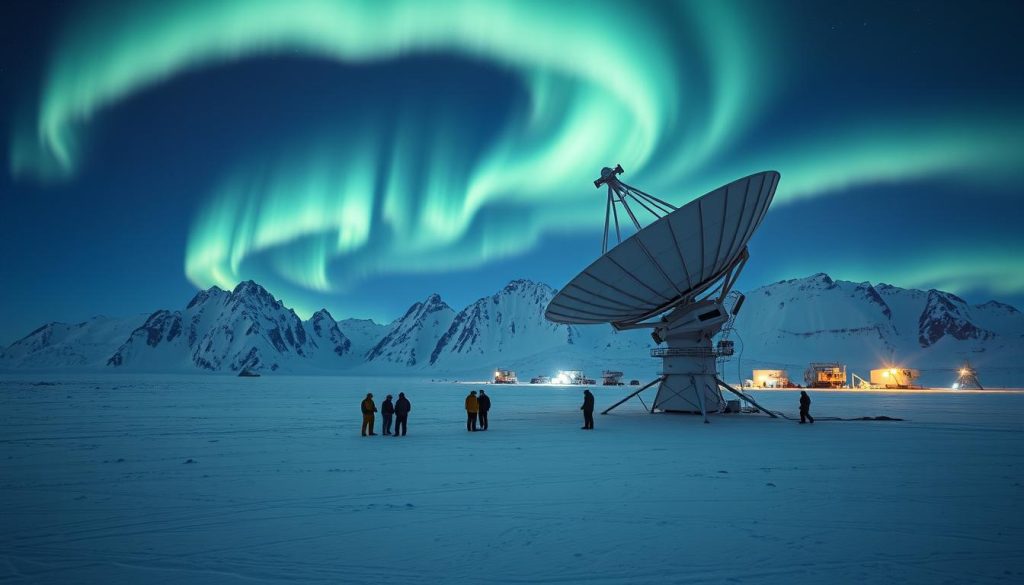
In Antarctica, talking to the world is key for research success. Researchers work in far-off spots where usual methods don’t work well. They need new ways to keep in touch all the time. This helps them do their work well and stay safe. Thanks to better satellite technologies, they can keep important communication channels open.
Satellite-Based Communication for Remote Areas
Satellite systems are crucial for talking in remote Antarctic research areas. These systems let researchers send data quickly and work together well. Companies like Inmarsat lead in making new tech for better connection in tough places. Satellite communication’s benefits include:
- Reliable data sending, no matter the place
- Quick sharing of research with partners worldwide
- Better safety with always-on communication
With these tools, science teams can do their important work better. They don’t have to worry about losing touch with key info and support.
Marketable Research Findings and Intellectual Property
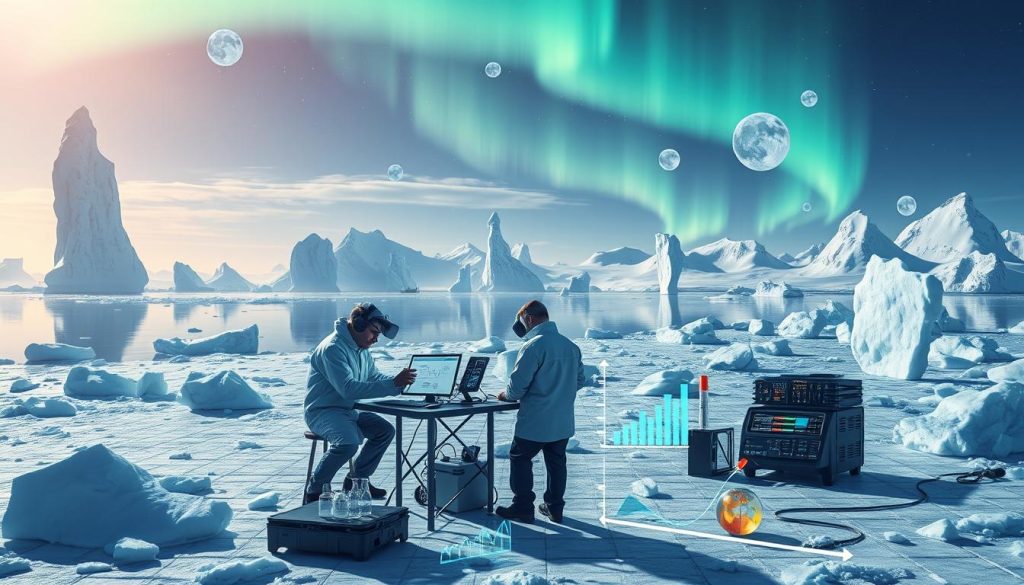
Antarctica’s scientific research is full of opportunities for new discoveries. These can become valuable and marketable findings. Turning these groundbreaking insights into profitable ventures is key. For this, securing intellectual property is crucial.
Commercialisation of Scientific Discoveries
Groups focusing on scientific discoveries’ commercialisation can use Antarctic research findings. This ensures that these advancements reach beyond academic journals. To market these discoveries successfully, several steps are needed:
- Identifying promising research that has the potential for commercial applications.
- Securing intellectual property rights to safeguard the innovations.
- Establishing partnerships with businesses that can facilitate the market launch.
- Engaging in strategic marketing to reach potential customers and investors.
These steps show how research and entrepreneurship can work together for commercial success. Recent success stories show researchers who manage intellectual property well and promote their findings. These achievements inspire others to find the business potential in their research.
Adventurous Tourism and Scientific Exploration
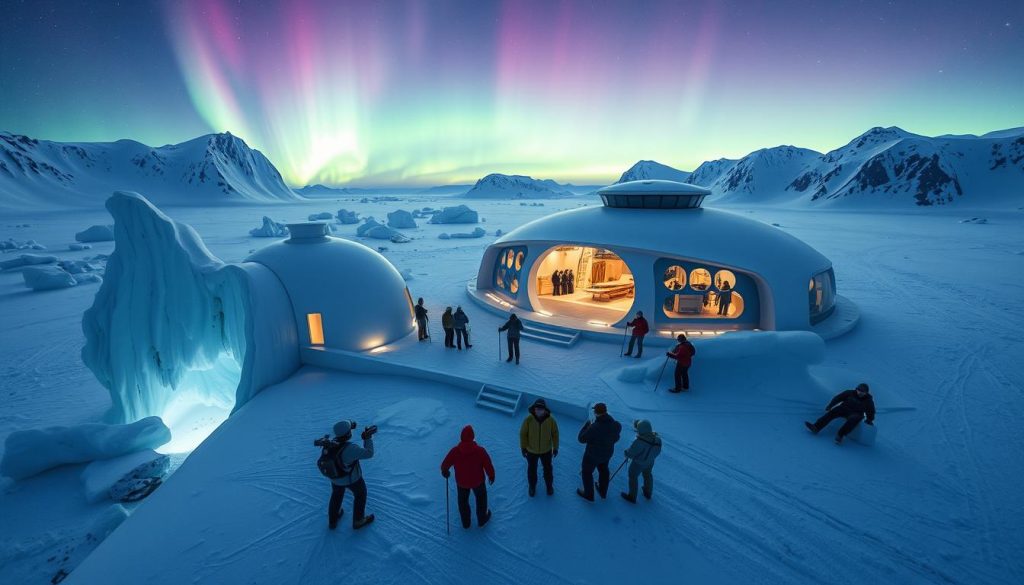
Antarctica’s tourism is growing, blending adventure with science. This mix gives educational chances and highlights urgent environmental matters. Organisations offer trips that expand knowledge about Antarctic life and climate issues.
Educational Tours for Students and Enthusiasts
Educational trips are inspiring the future’s scientists and green champions. They let people see why we must look after our environments. Such tours offer:
- Learning about scientific work and methods.
- Meeting experts who share their insights and ongoing work.
- Growing the public’s interest in science tours, increasing respect for the research in cold places.
People who’ve gone on these trips say they boost interest in science jobs and caring for our planet. The trips use the reality of climate changes to encourage talks that last beyond the journey.
Healthcare Innovations for Harsh Environments
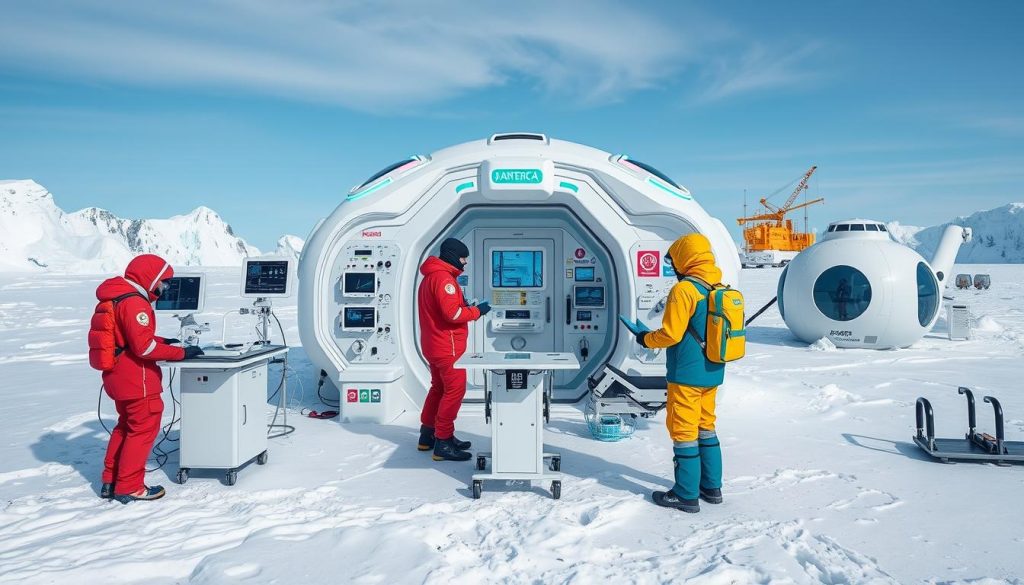
In Antarctica, scientists and support staff face tough health challenges due to severe weather. It’s vital to have effective healthcare solutions there. Innovations like telemedicine and portable medical units have greatly improved medical care in these icy regions.
Telemedicine allows for real-time talks with health experts. This means quick access to medical advice from far away. It’s key for quick diagnoses and treatments, cutting down on the need for physical travel. Also, there are portable medical units. They come packed with crucial medical supplies and gear for the cold extremes.
Many research stations have shown how well these healthcare innovations work. Telemedicine, for instance, keeps staff safe. It lets them deal with small health issues without risky travels over dangerous ice. The portable units are great for first aid and keeping patients stable until more help comes.
These steps highlight the need for ongoing healthcare innovation in icy worlds. Better healthcare doesn’t just keep people healthy. It also supports the success of vital research in these tough spots.
Utilising Artificial Intelligence in Research

Artificial intelligence (AI) plays a big part in science, especially in tough places like Antarctica. It changes how we gather, process, and look at data. Machine learning, for example, helps analyse huge amounts of data about climate change and nature.
Using AI in Antarctica means we can make better guesses about the environment. Scientists use AI to examine lots of satellite images and sensor data. They find patterns that people might miss. This helps scientists make important discoveries for their research.
AI is also great for predicting the future using data we already have. This is key for studying changes in animals or ice sheets, which can be tricky and need lots of data.
Many journals have written about how AI is helping in research. These articles show that AI is very valuable in science. It leads to better ways of doing research and improved results, especially in extreme places like Antarctica.
Advanced Material Science in Extreme Conditions
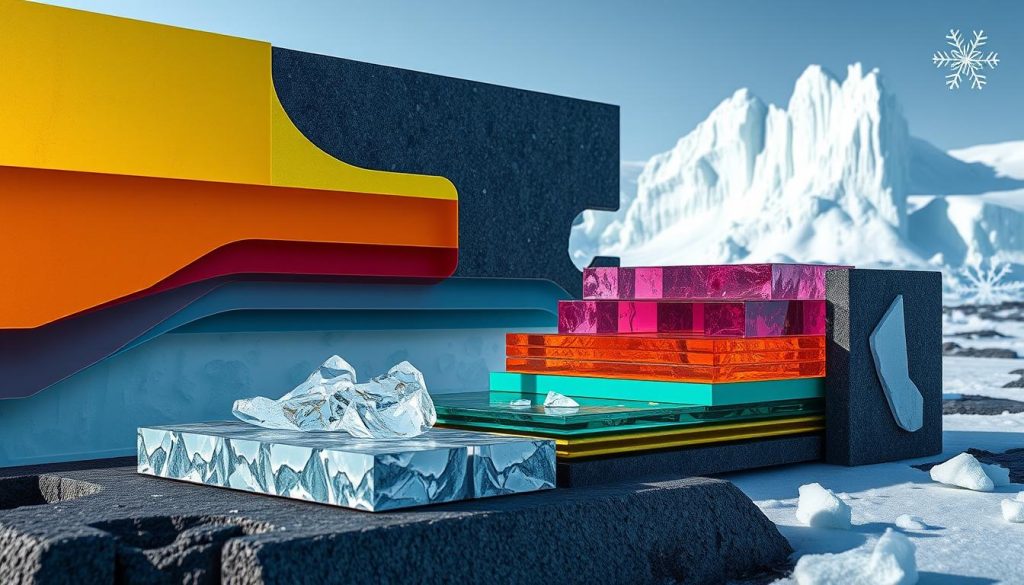
In Antarctica’s tough climate, material science advancements are crucial for research success. These studies demand new solutions for developing weather-proof materials. These materials boost the durability of gear and also make scientific work safer and more efficient.
Creating Weather-Resistant Materials
The University of Cambridge leads in making materials for extreme conditions. They aim to find traits that let materials withstand cold, wet, and windy weather. Their progress includes:
- Hydrophobic coatings that repel water, thereby reducing ice formation on equipment.
- Composite materials incorporating recent technological breakthroughs to enhance strength without adding weight.
- Smart fabrics equipped with sensors for monitoring environmental conditions and adjusting thermal insulation accordingly.
This work shows how material science can change tools used in polar research. It makes them stronger against the tough conditions of the planet’s most challenging places.
Business Networking Opportunities in Antarctica
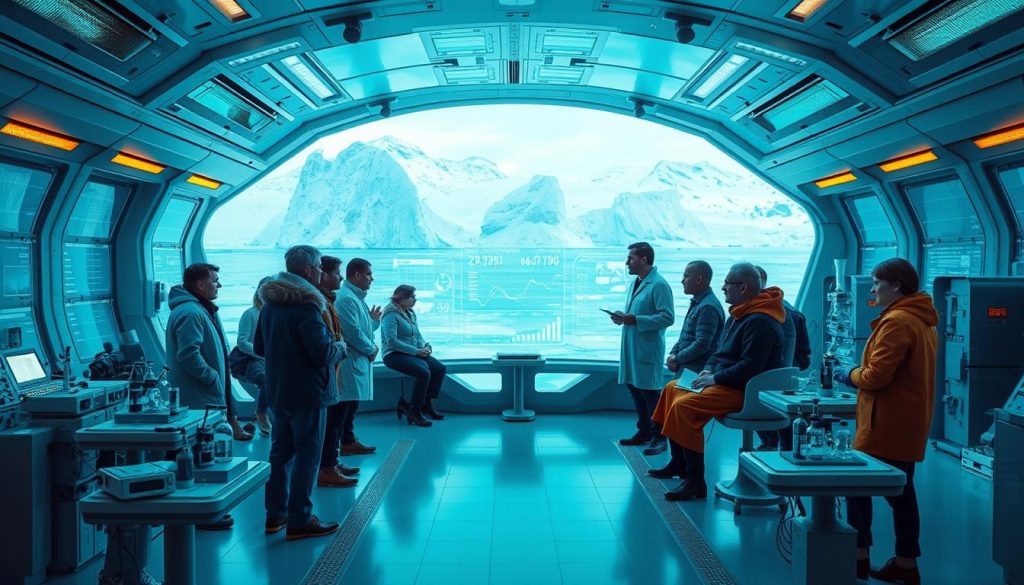
Networking in the science world is key in Antarctica. It helps research grow and brings about innovation. Scientists and business folks there should connect to unearth new chances. These ties boost their own work and polar science as a whole.
There are many ways to meet others, like conferences focused on polar studies. These gatherings are great for sharing ideas and starting partnerships. The main benefits of joining such events include:
- Access to funding and investment opportunities
- Collaboration on research projects with global institutions
- Improved visibility for your research findings
- Exchange of ideas and best practices among professionals
A solid network opens the door to success in Antarctica. It brings more resources and wisdom. Making valuable contacts helps not just your career but also the world of Antarctic research.
Logistical Services for Remote Research Stations
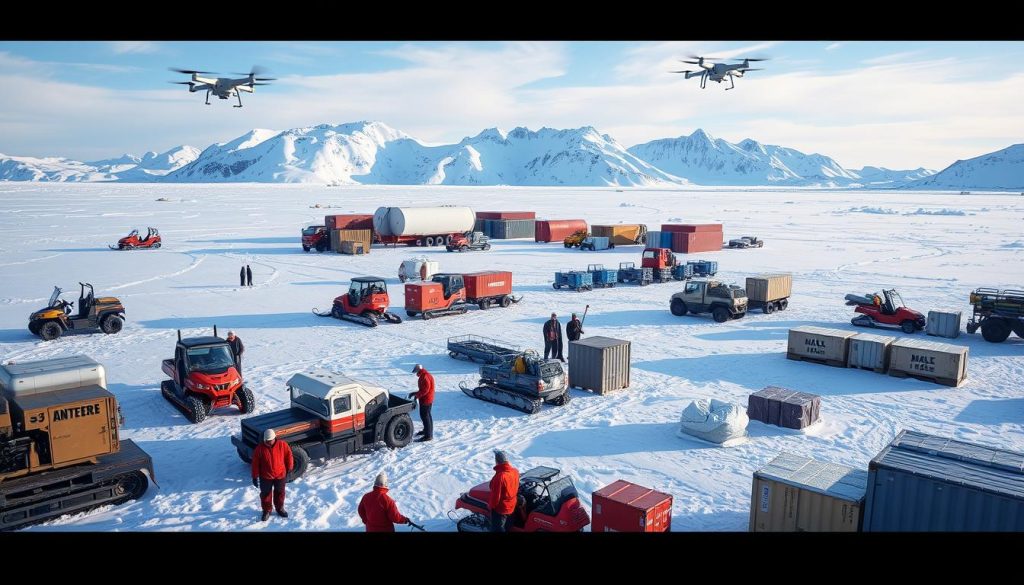
Working in Antarctica’s tough conditions brings unique logistical hurdles for research stations. It’s crucial to manage supplies well so resources reach on time and safely. This supports the important science work happening there. Logistics services that think outside the box are key to overcoming these obstacles. They aim to make running research stations smoother.
Innovations in Supply Chain Management
Supply chain updates in Antarctica have brought new methods suited for the cold and wild. Some fresh ideas include:
- Use of self-driving vehicles for moving supplies over dangerous ground.
- Systems that track goods in real time for better stock control.
- Using green energy for logistics, which lowers harm to the planet.
Top logistics companies are joining hands with science groups to boost how things run. By combining special logistical help and the latest tech, they ensure research bases can keep doing their crucial work. This is vital in tackling one of the planet’s toughest places.
The Importance of Sustainable Practices in Business
In the Antarctic, the need for sustainability in business stands out. Scientists and business minds are finding new ideas in this special place. They must use eco-friendly ways that help research and protect the environment. They have a duty to reduce harm to nature while making new discoveries.
Experts say it’s crucial to use sustainable methods in Antarctic research. Showing how to use green energy, cut down waste, and manage resources wisely is key. Doing this, researchers lead the way to a future where science and nature work together.
Sustainability in Antarctic research means balancing progress with caring for the planet. By choosing green practices, everyone involved makes a positive and lasting impact. This approach prepares the ground for discoveries that respect the unique Antarctic environment.

